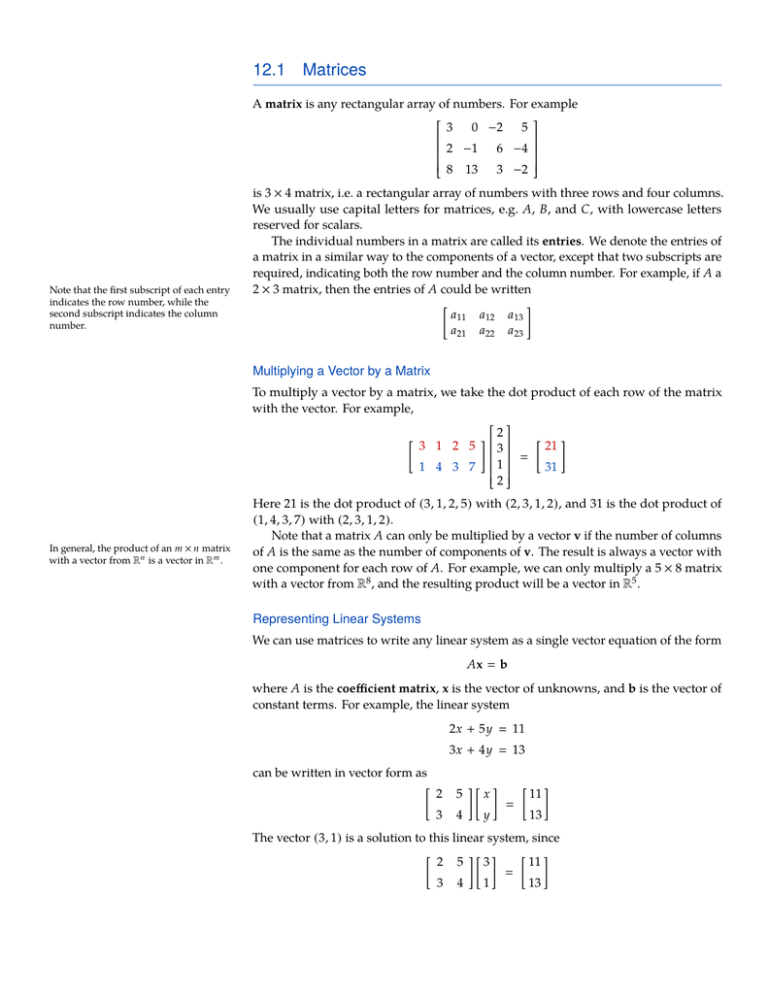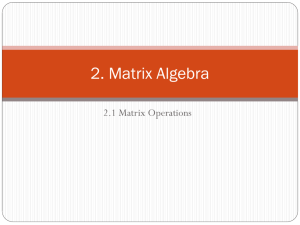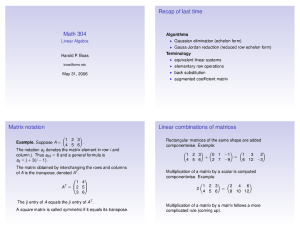12.1 Matrices
advertisement

12.1 Matrices A matrix is any rectangular array of numbers. For example 3 0 −2 5 2 −1 6 −4 8 13 3 −2 Note that the first subscript of each entry indicates the row number, while the second subscript indicates the column number. is 3 × 4 matrix, i.e. a rectangular array of numbers with three rows and four columns. We usually use capital letters for matrices, e.g. A, B, and C, with lowercase letters reserved for scalars. The individual numbers in a matrix are called its entries. We denote the entries of a matrix in a similar way to the components of a vector, except that two subscripts are required, indicating both the row number and the column number. For example, if A a 2 × 3 matrix, then the entries of A could be written " a11 a21 a12 a22 a 13 a 23 # Multiplying a Vector by a Matrix To multiply a vector by a matrix, we take the dot product of each row of the matrix with the vector. For example, # 2 " # 21 3 1 4 3 7 1 31 2 Here 21 is the dot product of (3, 1, 2, 5) with (2, 3, 1, 2) , and 31 is the dot product of (1, 4, 3, 7) with (2, 3, 1, 2) . " In general, the product of an m × n matrix with a vector from Rn is a vector in Rm . 3 1 2 5 Note that a matrix A can only be multiplied by a vector v if the number of columns of A is the same as the number of components of v. The result is always a vector with one component for each row of A. For example, we can only multiply a 5 × 8 matrix with a vector from R8 , and the resulting product will be a vector in R5 . Representing Linear Systems We can use matrices to write any linear system as a single vector equation of the form Ax b where A is the coefficient matrix, x is the vector of unknowns, and b is the vector of constant terms. For example, the linear system 2x + 5y 11 3x + 4y 13 can be written in vector form as " 2 5 3 4 x #" # y " 11 # 13 The vector (3, 1) is a solution to this linear system, since " 2 5 #" # 3 3 4 1 " 11 13 # MATRICES 2 Matrix Multiplication There is an operation called matrix multiplication that generalizes the product of a matrix and a vector. Given two matrices A and B, the product AB is the matrix obtained by taking the dot product of each row of A with each column of B. For example, if A and B are 2 × 2 matrices, then there are four dot products to compute: " " If A is an m × n matrix, and B is an n × p matrix, then AB is an m × p matrix. 7 5 1 2 #" 7 5 1 2 #" 2 0 3 1 # 2 0 3 1 # " " # 14 14 10 22 # " " 7 5 1 2 #" 7 5 1 2 #" 2 0 3 1 # 2 0 3 1 # " 14 22 # " 14 22 10 17 # This product only makes sense if the rows of A and the columns of B are vectors of the same size. In the example above, the rows of A and the columns of B are vectors from R2 , which makes it possible to take the dot products. In general, the matrix product AB is only defined if the number of columns of A is equal to the number of rows of B. When we compute the product AB, the result always has one row for each row of A and one column for each column of B. For example, if A is a 3 × 5 matrix and B is a 5 × 7 matrix, then AB is a 3 × 7 matrix. EXAMPLE 1 7 Compute AB if A 3 1 5 1 6 2 1 3 0 2 2 0 and B 2 0 1 3 2 . 4 0 SOLUTION Since A has three rows and B has two columns, the product AB is a 3 × 2 matrix. To compute the entries of this matrix, we must take the dot product of each row of A with each column of B. 7 3 1 5 1 6 2 1 3 0 2 2 0 2 0 1 3 16 2 4 0 7 3 1 5 1 6 2 1 3 0 2 2 0 2 0 1 3 16 2 4 4 0 7 3 1 5 1 6 2 1 3 0 2 2 0 2 0 1 3 16 2 4 4 18 0 7 3 1 5 1 6 2 1 3 0 2 2 0 2 0 1 3 16 2 4 0 39 7 3 1 5 1 6 2 1 3 0 2 2 0 2 0 1 3 16 2 4 4 0 7 3 1 5 1 6 2 1 3 0 2 2 0 2 0 1 3 16 2 4 4 18 0 39 15 39 39 15 39 15 27 Note that the product of a matrix A and a vector v is actually a special case of matrix multiplication. In particular, if we think of a vector v from Rn as a matrix with one column (i.e. an n × 1 matrix), then Av is the same as the product of the matrices A and v. MATRICES 3 Properties of Matrix Multiplication If A is an m × n matrix and B is an n × m matrix, then we can multiply them in either order, giving us two different products AB and BA. Surprisingly, these products are not usually the same! For example, if A is a 3 × 5 matrix and B is a 5 × 3 matrix, then AB is a 3 × 3 matrix and BA is a 5 × 5 matrix, so AB and BA do not even have the same size! Even if AB and BA have the same size, they are usually not the same matrix. For example, " 3 2 #" 1 2 7 1 1 2 # " 22 16 5 6 # " and 7 1 1 2 #" 3 2 1 2 # " 23 9 7 4 # In the language of abstract algebra, matrix multiplication is not a commutative operation. Though matrix multiplication is not commutative, it is associative. That is, if A, B and C are matrices, then A ( BC ) ( AB ) C Thus we can unambiguously write a product like ABC, without specifying whether A and B should be multiplied first or B and C should be multiplied first. For each n, there is a special n × n matrix called the identity matrix, which is usually denoted by the letter I. The 2 × 2, 3 × 3, and 4 × 4 identity matrices are shown below. " The identity matrix I can be thought of as a matrix analog of the number 1. 1 0 0 1 1 0 0 0 1 0 0 0 1 0 0 0 1 # 0 1 0 0 0 0 1 0 0 0 0 1 The identity matrix has the special property that AI A whenever AI is defined, and IB B whenever IB is defined. For example, " 1 0 0 1 #" 2 6 5 9 2 9 # " 2 6 5 9 2 9 2 3 " 2 3 # 1 4 1 0 1 4 0 1 1 5 1 5 # and Addition and Scalar Multiplication Matrix subtraction is defined in a similar way. There are three more basic operations involving matrices: addition, scalar multiplication, and transpose. Matrix addition works just like vector addition, with corresponding entries of the two matrices added together: " 2 2 1 1 1 5 # " + 3 5 5 2 1 2 # " 5 7 6 3 2 7 # Only two matrices of the same size can be added. Matrix multiplication distributes over addition from both the left and the right, i.e. A ( B + C ) AB + AC and (A + B ) C AC + BC Scalar multiplication for matrices is also quite similar to scalar multiplication for vectors: " # " # 4 3 1 8 6 2 2 4 2 3 8 4 6 This has a variety of obvious properties, e.g. k ( A + B ) kA + kB for any scalar k and matrices A and B. and k ( AB ) ( kA ) B A ( kB ) MATRICES 4 Matrix Transpose The transpose of a matrix is obtained by switching its rows with its columns. For example, the matrices 1 0 " # 1 5 3 5 2 and 0 2 4 3 4 are transposes of one another. If A is a matrix, its transpose is usually denoted AT . Taking the transpose reverses the order of matrix multiplication. That is, (AB ) T B T AT for any matrices A and B. For example, " 1 0 5 2 3 4 # 1 4 " # 3 1 22 18 14 14 2 3 " and 1 4 3 1 2 3 # 1 0 " # 5 2 22 14 18 14 3 4 Note also that the transpose of a transpose is the original matrix, i.e. AT T A Special Kinds of Matrices A square matrix is a matrix with the same number of rows and columns, such as a 2 × 2 matrix, a 3 × 3 matrix, or more generally an n × n matrix. We can multiply any two square matrices of the same size, with the product being another matrix of that size. A square matrix is symmetric if it is equal to its own transpose. For example, " It is all right if some of the diagonal entries of a diagonal matrix are zero. For example, 3 0 0 0 is a perfectly good diagonal matrix. 2 4 4 3 # and 3 5 1 5 9 6 1 6 4 are symmetric matrices. Note that the diagonal entries of a symmetric matrix (highlighted in red) can be any numbers at all, but the off-diagonal entries must be equal in pairs. A diagonal matrix is a square matrix whose off-diagonal entries are all zero. For example, 5 0 0 " # 4 0 0 2 0 and 0 3 0 0 6 are diagonal matrices. Note that a diagonal matrix is always symmetric. Diagonal matrices are particular easy to multiply: one need only multiply the corresponding diagonal entries. For example, 1 0 0 5 0 0 5 0 0 0 2 0 0 7 0 0 14 0 0 0 3 0 0 11 0 0 33 An upper-triangular matrix is a square matrix that has zeroes below the main diagonal. For example, " 4 0 2 3 # and 5 3 1 0 2 7 0 0 6 MATRICES 5 are upper-triangular. The product of two upper-triangular matrices of the same size is again upper-triangular, e.g. " 3 0 2 4 #" 2 0 # 2 1 " 6 0 8 4 # Note that every diagonal matrix is upper triangular, and that a matrix is diagonal if and only if it is both upper-triangular and symmetric. The transpose of an upper-triangular matrix is called a lower-triangular matrix. Such matrices have zeroes above the main diagonal: " 4 2 0 3 5 0 0 3 2 0 1 7 6 # and Again, the product of two lower-triangular matrices is lower-triangular. Note that a matrix is diagonal if and only if it is both upper triangular and lower triangular. EXERCISES 8 0 4 6 1. If A 3 1 2 4 , what is a 23 ? 5 7 5 1 Multiply. 2–5 −9 2. 2 3 1 2 4. 0 6 −5 1 3. 9 −1 3 1 −3 9 −3 1 0 8 1 7 8 1 9 2 2 1 2 2 0 1 1 2 0 2 0 0 0 5. 0 0 1 6 5 1 0 4 0 0 3 2 0 Find a vector x such that Ax b. 6–7 " −8 6. A 1 # " 9 −20 , b −3 10 # 8. Find the values of x and y for which " 9. " 6 4 2 7. A 1 2 −2 , b 1 1 −3 " #" # " # x 4 1 −2 y 2 2 5 7 8 . 0 Multiply. 9–14 11. 1 " # 7 5 0 −2 1 6 4 3 −1 #" 1 0 3 −8 #" −1 8 1 3 2 1 3 0 # " 1 9 f 1 10. 2 2 # 12. # −1 −4 3 9 1 0 −1 2 1 −2 −2 2 0 −6 g " 3 −4 # 7 1 −1 MATRICES 13. f 8 6 −1 g 2 7 3 −1 14. " #f 2 3 3 −2 1 g 15. Let A and B be 3 × 3 matrices, and let C AB. Given that a32 b32 0, a31 4, b12 3, and what is the value of c32 ? " 0 16. If A 2 # 1 , compute ATA − 3A. 3 " # " # 2 8 17. Find a 2 × 2 diagonal matrix A such that A . 3 −6 " 18. Find a 2 × 2 upper-triangular matrix A such that A + AT " 19. Find a 2 × 2 matrix A such that 4A − 2AT 6 2 # 6 5 5 . 8 # 8 . 2 20. Find a 2 × 2 symmetric matrix A such that " # " # 1 A 0 5 3 and f 0 g 1 A f 3 g 4 .







